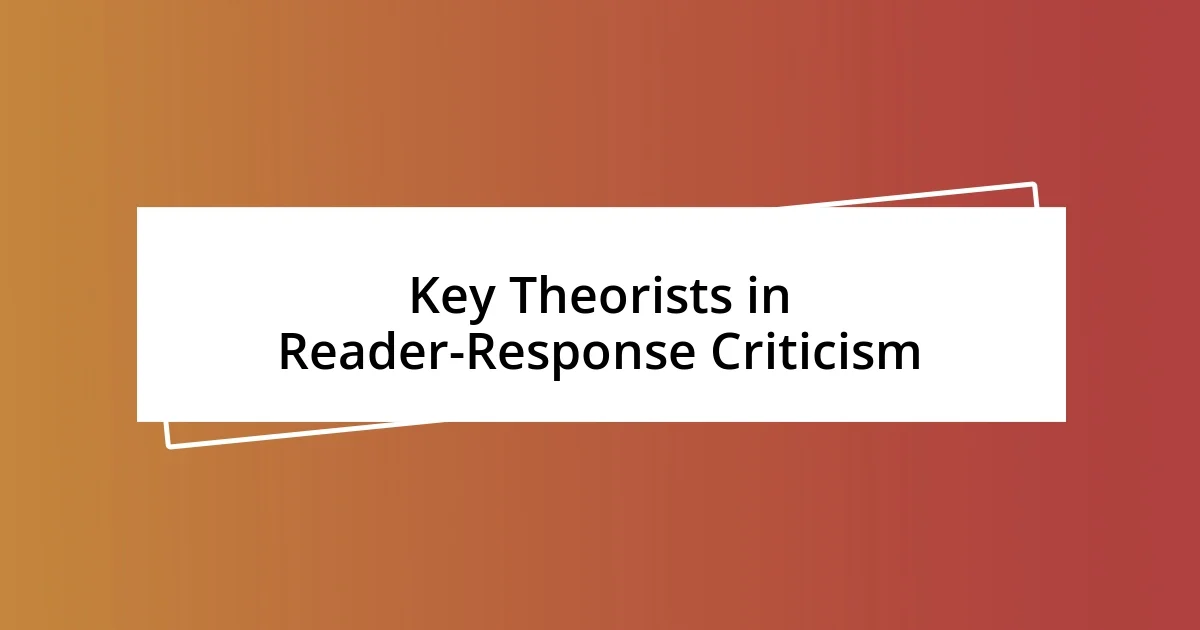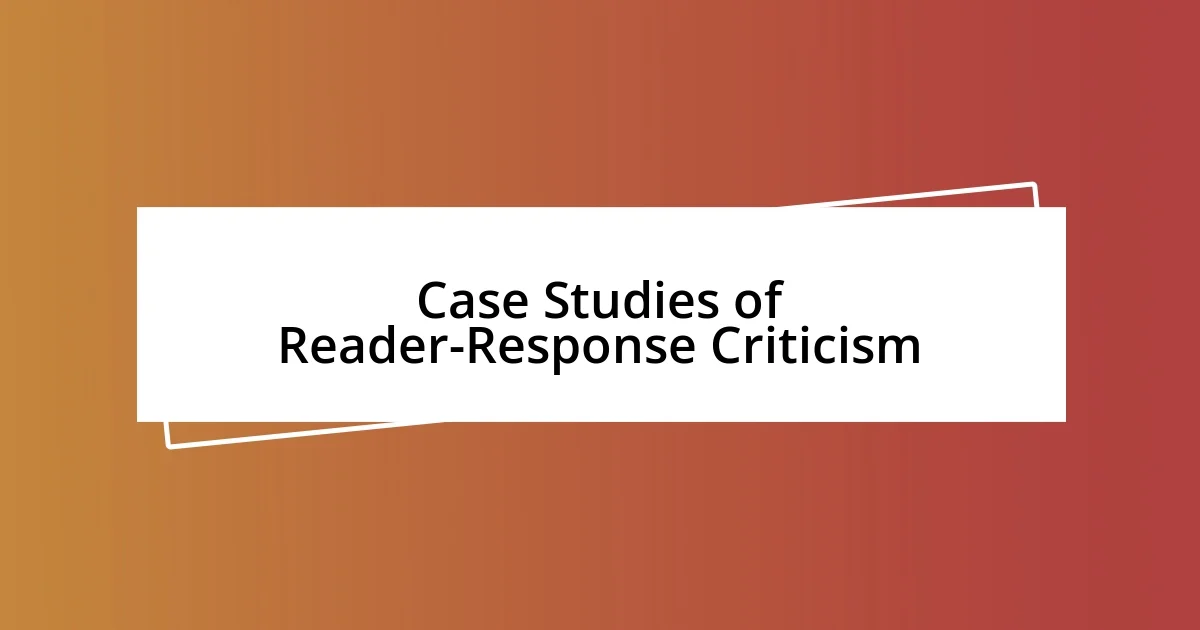Key takeaways:
- Reader-response criticism emphasizes the reader’s emotional connection and interpretation, enriching literary analysis by acknowledging individual experiences.
- Key theorists like Stanley Fish, Wolfgang Iser, and Roland Barthes highlighted the importance of reader interactions, interpretive communities, and the irrelevance of authorial intent in meaning-making.
- Practical applications, such as engaging discussions and personal reflections, enhance reader engagement and reveal diverse interpretations of texts in educational settings.

Understanding Reader-Response Criticism
Reader-response criticism shifts the focus from the text itself to the reader’s experience and interpretation. I’ve often found that this approach makes literature feel more alive, as my emotional responses can give a unique perspective to a story. Have you ever read a novel and felt a surge of nostalgia? That personal connection is exactly what reader-response critics explore.
When I first encountered reader-response criticism, it was as if a door opened to a new way of engaging with texts. I remember reading “The Catcher in the Rye” and being struck by Holden Caulfield’s voice. My own experiences of teenage angst resonated deeply with his struggles, which led me to appreciate aspects of the story that I might have overlooked previously. Isn’t it fascinating how our backgrounds shape our interpretations?
This critical lens encourages us to embrace our individual feelings and thoughts as valid components of literary analysis. By acknowledging our reactions, we can create a richer dialogue with the text and uncover deeper meanings. It’s about recognizing that each reader brings a unique lens shaped by personal history and emotion—something I believe is invaluable in understanding literature. What insights have you gained from the books that have touched you?

Historical Background of Reader-Response
Reader-response criticism emerged in the mid-20th century, evolving as a reaction against more traditional literary theories that prioritized the author’s intent or the text itself. I often find it intriguing to think about how literary scholars began realizing that the interaction between the reader and text was just as important, if not more so. It felt groundbreaking when I first learned that our emotional reactions and interpretations could shape a story’s meaning.
- Influences from psychoanalysis and phenomenology played a significant role in shaping this approach.
- Pioneering figures, like Stanley Fish and Wolfgang Iser, emphasized the active role of readers in creating meaning.
- During the 1960s and 70s, this criticism gained traction as literature departments began embracing diverse interpretations.
Reflecting on this evolution, it reminds me of a book club discussion I once had about a classic novel. Each member brought their unique perspective, leading to a rich tapestry of interpretations that enthralled me. It reinforces my belief that literature isn’t static; rather, it breathes and shifts based on who is engaging with it.

Key Theorists in Reader-Response Criticism
Reader-response criticism owes a great deal to key theorists who illuminated this approach. Stanley Fish, for instance, developed the concept of “interpretive communities,” suggesting that readers are shaped by shared experiences and cultural backgrounds, which influence how they approach a text. I once discussed this in class while analyzing a poem, and it struck me how different our interpretations were based solely on our personal backgrounds. It made me realize how much our communities color our understanding of literature.
Another significant theorist, Wolfgang Iser, focused on the gaps or “blanks” in texts that allow readers to fill in the meaning, essentially making the reader an active component of the storytelling process. When I encountered Iser’s ideas, it was like a light bulb moment for me. I considered how I often fill in emotional gaps while reading, reflecting on my own life experiences. This personal involvement can enrich one’s reading experience in profound ways, wouldn’t you agree?
Lastly, Roland Barthes took a unique stance by asserting that the author should not hold authority over the text’s meaning. I remember feeling liberated when I first came across his work; it opened my mind to the idea that a text belongs to its readers. This realization encouraged me to explore literature without the constraints of authorial intent, emphasizing that what I derive from a story is just as important. This concept has been pivotal in how I engage with books since.
| Theorist | Key Contribution |
|---|---|
| Stanley Fish | Introduced the concept of ‘interpretive communities’ wherein readers’ backgrounds shape their interpretations. |
| Wolfgang Iser | Emphasized the role of gaps in texts that require readers to actively construct meaning. |
| Roland Barthes | Argued that the author’s intent is irrelevant to the reader’s interpretation of the text. |

Practical Applications in Literature
One of the most exciting practical applications of reader-response criticism in literature is in classroom settings. I recall a time when my professor encouraged us to pick a character from a novel and write a letter to them. This exercise opened up emotional dialogues, allowing us to express in-depth feelings and clarifications that were often overlooked. Doesn’t it feel revolutionary when we can engage with characters as if they are real people in our lives?
In workshops or book clubs, I’ve witnessed firsthand how reader-response criticism cultivates a richer understanding of texts. During a discussion on a complex story, everyone brought different interpretations shaped by their experiences. I was fascinated to see how some struggled with the theme of loss, while others embraced it. It made me wonder: how much does our life journey influence our understanding of a text? Each perspective not only helped me comprehend the narrative better, but it also fostered a deeper connection with fellow readers.
Moreover, writing personal reflections after reading can illuminate the ways in which literature resonates with our individual experiences. I often jot down my thoughts about how a plot twist mirrors my own life choices, which adds layers to my understanding of the work. This practice not only personalizes my reading but also enhances the text’s relevance in my life. After all, aren’t we all searching for meaning in stories that echo our own realities?

Challenges in Reader-Response Analysis
Challenges in reader-response analysis often arise from the inherent subjectivity of interpretation. Each reader brings their unique experiences, emotions, and biases, which can lead to vastly different understandings of the same text. I remember grappling with this during a debate with friends about a novel—we simply couldn’t agree! It left me wondering: how can we ensure our interpretations remain valid when they can diverge so dramatically?
Another challenge I’ve found is balancing individual insight with textual evidence. While I cherish the freedom of personal interpretation, I sometimes struggle with incorporating the original text into my analysis. It’s like trying to play jazz without keeping the rhythm of the song; without that grounding, my thoughts risk becoming too far removed from the author’s intent. Have you ever been in this position where your creative interpretation felt unsupported?
Lastly, there’s the risk of oversimplifying complex themes when reading solely through a personal lens. I’ve caught myself at times reducing a multifaceted character to a single trait based on my own life experience, which limits my broader understanding of the narrative. This limitation makes me ponder: how can we push ourselves to explore deeper layers of meaning while acknowledging our perspectives? Engaging in discussions with others often helps me navigate these waters, revealing perspectives that challenge my own and enhance my comprehension of the text.

Enhancing Reader Engagement Techniques
Engaging readers more deeply can sometimes be as simple as asking thought-provoking questions. In a recent book discussion, I threw out a question like, “What if the protagonist had made a different choice at a crucial moment?” This sparked a lively debate and allowed everyone to explore alternate realities within the text. Isn’t it fascinating how a single question can unlock so many interpretations and emotions?
Another technique I’ve found valuable is creating visual representations of characters or themes. I remember one workshop where we were tasked with mapping out character relationships on a large poster. As we illustrated connections and conflicts, not only did it enhance our critical thinking, but it also transformed our discussions into vibrant dialogues. Seeing how each thread intertwined was like watching the story come to life, and I think it’s a powerful way to engage with literature more vividly.
Finally, incorporating multimedia elements can be a game-changer. When I played a short film adaptation of a novel alongside our reading, the visuals evoked different emotions and sparked fresh insights. Suddenly, we weren’t just analyzing the text; we were experiencing it in a new, dynamic way. Have you ever thought about how music or video can enhance your understanding of a narrative? It truly broadens the engagement and brings layers to the discussion that pure text sometimes can’t convey.

Case Studies of Reader-Response Criticism
One captivating case study that highlights reader-response criticism in action is the varying interpretations of George Orwell’s 1984. When I first read this novel, it struck me as a stark warning about totalitarian regimes, but during a discussion group, one participant framed the story as a reflection on personal autonomy. This contrast made me realize how a single text can unveil different fears and hopes based on individual life experiences. Have you ever had a moment where someone’s perspective shifted your entire view of a story?
In my own teaching experience, I’ve used Toni Morrison’s Beloved as a focal point for exploring reader responses. Students often connect with the emotional weight of the characters’ experiences differently. I remember one session where a student shared how Sethe’s choices resonated with their understanding of motherhood, leading to a profound conversation about historical trauma and personal connection. It left me thinking: how do our own narratives intertwine with the stories we read?
Another compelling example involves the multiple interpretations of The Great Gatsby. When discussing Jay Gatsby’s unyielding pursuit of the American Dream, I found that some readers viewed him as a tragic figure, while others saw him as an embodiment of hope. This divergence led to a rich dialogue, making me question how societal values shape our perspectives. Have you ever felt that a character represented something bigger than themselves? Engaging with others on this topic can unveil layers of meaning that I might never have considered on my own.














